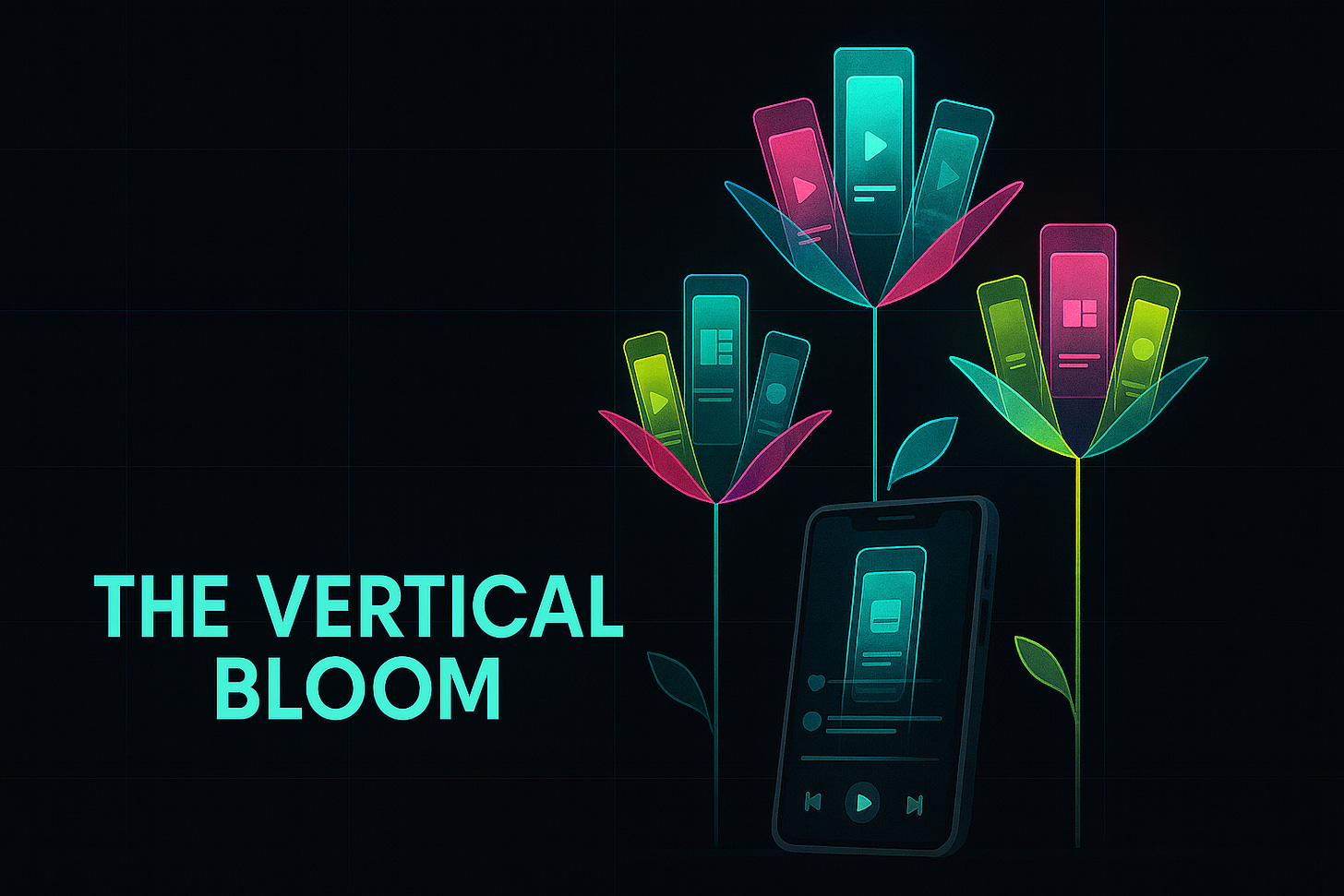The Vertical Bloom: 10/30/25
Your guide on the happenings of the vertical drama landscape.
Welcome to The Vertical Bloom, a weekly dive into the fast-growing world of microdramas and vertical storytelling. Here, we unpack the platforms, creators, and deals shaping the format that’s quietly redefining what it means to make—and watch—television in the mobile age.
Fresh Takes
Bill Block, Former Miramax Boss, Launches Microdrama App ‘GammaTime’… a U.S.-based vertical video platform aiming to fuse studio polish with TikTok pacing. Backed by $14 million in seed funding from VGames, Pitango, and Traverse Ventures—with Kim Kardashian among its investors—the startup’s leadership takes ex-Google Gaming exec Slava Mudrykh as CRO and Alex Montalvo, formerly of Quibi, as CCO.
Launched October 23rd, GammaTime debuted ~20 original series spanning thrillers, romances, and true crime, including a project penned by CSI creator Anthony E. Zuiker. As Hollywood heavyweights like Block rush to stake their claim in the microdrama gold rush, one question lingers: is this the industry’s bold new sandbox for reinvention—or just the same old playbook, flipped vertical?
Some Quotes from their Executive Team:
“While early micro-drama apps proved the storytelling format works, they’ve barely scratched the surface of what’s possible…” (Bill Block, CEO; Source)
“We are a demand-driven, technologically determined content app where the next billion consumers will discover premium stories to satisfy their appetite.” (Bill Block, CEO; Source)
“We’re bringing the same data-driven sophistication to storytelling that top mobile games use for player engagement…” (Slava Mudrykh, CRO; Source)
“Every story is tested and optimized before full production. It’s not about replacing creativity — it’s about amplifying it by aligning with what audiences truly crave.” (Slava Mudrykh, CRO; Source)
Bill Block (top) unveils the GammaTime logo and platform UI…
Chinese Tech Titan Xiaomi Launches Ad-Free Microdrama App ‘Weiguan Short Drama’.
Xiaomi is turning screens into stages. The tech giant behind smart phones and smart homes has launched an exclusive, ad-free microdrama app for its users—rolling out in October 2025 with 20,000+ downloads and content spanning 20 genres. Blending streaming with social, it lets viewers comment, rank, and react in real time. It’s less a content play than a loyalty move—a vertical entertainment hub built into the ecosystem its users already live in.
Report Shows that the Majority of Ad Spending from Microdramas went to Social Media in 2025…
When Lucas Shaw “sold” microdramas on Matt Belloni’s The Town podcast—recorded live at Bloomberg’s Screen Time—he claimed the format was peaking on the Gartner Hype Cycle, moments away from a crash. Belloni agreed, admitting he didn’t know a single person who watches them. But new Sensor Tower data may explain that disconnect—68% of ad spending from top microdrama platforms in 2025 went to Facebook, TikTok, Instagram, and Snapchat. If discovery lives entirely within those ecosystems, then Shaw and Belloni simply aren’t in the algorithmic loop. Their feeds don’t lead them there—and that’s the case for many outside that bubble…
Platform Spotlight
FlareFlow is COL Group’s latest experiment in scaling emotion. The Singapore-based app—sibling to ReelShorts under the Crazy Maple Studios umbrella—extends the company’s microdrama factory model beyond China, blending its data-driven production pipeline with a globalized slate of vertical storytelling. Budgets are capped around $300K per title, output targets hover near 100 originals this year and 180 next, with HQ’s split between Los Angeles and mainland China.
Within months of launch, FlareFlow cracked the Top 5 in the U.S. App Store’s Entertainment category. Downloads surged 1,500% in just three months, and revenue reportedly more than doubled. The platform now spans 177 regions and over +20 million downloads (Source), propelled by a deceptively simple creative mantra: empathy-conflict-release (Source). All signs point to FlareFlow becoming a serious contender in the West—not because it’s reinventing the format, but because it’s perfecting the machine behind it.
FlareFlow Logo // Poster for Top Performing Title ‘She Said Yes, They Said Oops’
Show Spotlight
Girls Help Girls: Divorce or Die (NetShort):
Logline: Caroline, a top Abuse Intervention Specialist at PunishDash with an unmatched record of subduing abusers, fell for Richard—a disguised domestic violator—during a blind date. They married swiftly. When Richard attempted to control her, she overpowered him, delivering brutal retaliation. Ironically, Richard as the abuser ended up a victim of his own abuse.
Genre: Secret-Identity / Revenge
This 59-part, U.S.-produced series stands as one of NetShort’s breakout hits, diverging from the revelation to redemption arcs typical of Asian microdramas to embrace a sharp, driven revenge narrative—one seemingly tailored to Western appetites. With roughly 400K saves and 60K likes, it’s fast, visceral, and instantly legible—mixing romance, betrayal, and complex action sequences into two-minute bursts engineered for maximum scroll-stopping impact.
To understand what this kind of success means for the industry, I turned to the people shaping it behind the scenes…
Industry Insider
Screenwriter Alison Bonn cleverly outlines the stark similarities—and differences—between feature screenplays and microdramas. The fundamentals of a feature, she argues, are what make a vertical sing. The difference? Time. There’s no 25-page runway to build a world—stakes and tone must land in the first episode, sometimes in the first 30 seconds. It’s a compression test for craft. Bonn insists that clarity, not complexity, is what separates a scroll-stopper from a skip. Character dynamics must read instantly, their motivations obvious yet layered. In the end, she says, whether the story unfolds horizontally or vertically, the mission is the same: hold attention, trigger emotion, and never let go.
A former microdrama director that worked for a top-performing platform lifted the curtain on what really drives the genre’s addictiveness: a structural weapon called Loops. In these vertical scripts, act structures and pacing can’t work the same. To remedy this, Loops—or, moments of intense drama, suspense, or revelation—are algorithmically placed in order to maintain attention.
A Mini-Loop is the micro perspective. Verbatim from our source: “How are we torturing our protagonist, and how often?” The beginnings of a microdrama typically go as such: a woman working as a maid, being underpaid and abused, learns that she is actually the heiress to the throne/company/family-fortune. Until she acts upon it, we watch episode after episode as she endures suffering on her way to the eventual twist.
A Core Loop is the macro lens. How will our protagonist exact revenge? When will the audience get to feel catharsis, and how can these small moments of trauma fit into the narrative structure of the overall story? The moment the woman learns that she is some sort of heiress, and the narrative through-line of her finding out how to gain control, are the core loops of the story.
Writers then count and calibrate the presence and pacing of these Loops with surgical precision: How many before the midpoint? How many per emotional beat? Per page? The answer varies by genre, but the math matters, and is formulaic. A Loop lands on the edge of an episode without fail, with paywalls written into the script, engineered to dangle one more unanswered question—one more micro-purchase away from satisfaction.
See you next week!








Great coverage from a fast moving medium!
Will be interesting to see the “Western Approach” develop, if ever, and how it differs from its Eastern-influenced precursor.
great coverage!